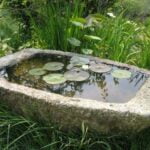Are you interested in vegetable gardening but don’t have a spacious yard to work with? Look no further. In this article, we will explore the world of vegetable gardening creative container gardening ideas that are perfect for small spaces. Whether you live in an urban area or simply want to add some greenery to your balcony or patio, container gardening offers a convenient and efficient way to grow your favorite vegetables.
Container gardening has become increasingly popular due to its numerous benefits. From limited space requirements to easier maintenance and mobility, growing vegetables in containers can be a game-changer for many gardeners. In this article, we will delve into the various advantages of container gardening and how it can open up exciting possibilities for vegetable cultivation.
You’ll also discover tips on choosing the right containers for your vegetables, get inspired by creative container ideas suitable for small spaces, learn about vertical gardening techniques, explore seasonal considerations for container vegetable gardening, and gain valuable insights into successful vegetable cultivation in urban environments. So whether you’re a seasoned gardener or a beginner looking to embark on a new horticultural adventure, this article is packed with innovative ideas and practical advice for your vegetable gardening endeavors.
Choosing the Right Containers for Vegetables
When it comes to vegetable gardening, choosing the right containers is crucial for the success of your plants. The type of container you use can affect the growth and health of your vegetables, so it’s important to make an informed decision. Here are some key factors to consider when choosing containers for your vegetable garden.
Material
The material of the container plays a significant role in the health of your vegetables. Plastic, wood, ceramic, and metal are popular choices for containers. Plastic is lightweight and affordable, but may not be as aesthetically pleasing as other materials. Wood offers good insulation for plant roots but may rot over time. Ceramic containers are attractive but can be heavy and expensive. Metal containers can heat up quickly in sunny weather, which may affect the temperature of the soil.
Size
The size of the container is important for the proper growth of vegetables. Some vegetables, such as tomatoes and peppers, require larger containers with ample space for root growth. On the other hand, smaller containers are suitable for herbs and salad greens. It’s important to consider the mature size of the vegetable plant when selecting the size of your container.
Drainage
Proper drainage is essential for preventing waterlogged soil, which can lead to root rot in vegetables. Look for containers with drainage holes at the bottom to allow excess water to escape. If you’re using a decorative or repurposed container without drainage holes, consider adding a layer of rocks or pebbles at the bottom to improve drainage.
By carefully considering these factors when choosing containers for your vegetable garden, you can create an ideal environment for your plants to thrive. Whether you opt for traditional plastic pots, repurposed wooden crates, or innovative self-watering containers, finding the right fit will set you on the path to successful vegetable gardening in containers.
Creative Container Ideas for Small Spaces
Small spaces should not limit your ability to enjoy the benefits of vegetable gardening. With a little creativity and resourcefulness, you can still grow an abundant garden in containers, even if you have limited space. Here are some creative container ideas for small spaces to help you get started.
Window Boxes and Hanging Baskets
If you live in an apartment or have a small balcony, consider using window boxes and hanging baskets to grow vegetables. These options are perfect for small spaces as they can be hung on walls or railings, maximizing vertical space. You can plant leafy greens such as lettuce and spinach, herbs like basil and parsley, or even compact varieties of tomatoes and peppers in these containers.
Stackable Pots and Tiered Planters
Stackable pots and tiered planters are excellent solutions for vertical gardening in small spaces. These innovative containers allow you to stack multiple layers of plants, effectively increasing your growing area without taking up much floor space. They are ideal for growing various vegetables such as strawberries, radishes, carrots, and even small root crops like potatoes.
Compact Vegetable Varieties in Small Pots
When space is limited, opt for compact vegetable varieties that thrive in small pots. Cherry tomatoes, dwarf zucchini, bush beans, and mini bell peppers are just a few examples of vegetables that can flourish in small containers. Look for specific “patio” or “bush” varieties that are bred to grow well in confined spaces so that you can enjoy a bountiful harvest despite the limitations of your gardening area.
By utilizing these creative container gardening ideas for small spaces, anyone can enjoy the satisfaction of growing their own vegetables regardless of living situation or available outdoor area. With the right containers and careful planning, urban dwellers and those with limited outdoor space can still experience the joy of harvesting their own home-grown produce.
Vertical Gardening With Vegetables in Containers
Vertical gardening is a great way to maximize space and productivity in your vegetable garden. By utilizing containers, you can create a stunning visual display while also reaping the benefits of a bountiful harvest. There are many creative container gardening ideas for vertical vegetable gardening that can be easily implemented in any space, no matter how small.
One popular method for vertical gardening with vegetables in containers is the use of trellises or stakes. This allows vining plants such as tomatoes, cucumbers, and peas to grow upwards rather than outwards, saving valuable ground space. Additionally, utilizing hanging baskets and tiered plant stands can also increase the vertical growing area for your vegetables.
Another innovative idea for vertical vegetable gardening in containers is the use of repurposed items such as old ladders, pallets, or even shoe organizers. These items can be transformed into unique and eye-catching vertical gardens, perfect for urban dwellers or those with limited outdoor space.
When choosing containers for vertical gardening with vegetables, it’s important to select ones that are sturdy enough to support the weight of the plants and soil. Additionally, ensure that the containers have proper drainage to prevent waterlogged soil which can lead to root rot. With the right containers and some creativity, anyone can enjoy a thriving vertical vegetable garden on their patio, balcony, or even indoors.
| Vertical Gardening Ideas | Benefits |
|---|---|
| Use of trellises or stakes | Maximizes space |
| Repurposed items (e.g. ladders, pallets) | Suitable for urban dwellers |
| Hanging baskets and tiered plant stands | Increase growing area |
Seasonal Vegetable Gardening in Containers
When it comes to vegetable gardening, many people assume that they need a large plot of land in order to grow their own produce. However, with the right knowledge and some creative container gardening ideas, it is possible to grow a wide variety of vegetables even in small spaces or urban settings. One of the key aspects of successful vegetable gardening in containers is understanding how to adapt to the changing seasons.
In the spring and summer months, you can take advantage of warm weather crops such as tomatoes, peppers, cucumbers, and zucchini. These vegetables thrive in containers and can provide a bountiful harvest if given adequate sunlight and water. For those with limited space, vertical gardening techniques can be used to make the most of available space by growing vining vegetables like beans or peas on trellises or upcycled ladders.
As the seasons change and temperatures drop, it’s time to transition your container garden to cool weather crops such as lettuce, spinach, kale, and carrots. These vegetables are well-suited for containers and can withstand lower temperatures, allowing you to continue your vegetable gardening well into the fall and even winter months with proper protection from frost.
One example could be how tomato plants perform best when daytime temperatures are around 80 degrees Fahrenheit (27°C) and nighttime temperatures are not lower than 60 degrees Fahrenheit (15°C). When you grow tomatoes in containers, you have the flexibility of moving them indoors during cooler nights or placing them strategically where they get the ideal amount of sun during cooler seasons like autumn.
| Vegetable | Ideal Season |
|---|---|
| Tomatoes | Spring/Summer |
| Lettuce | Fall/Winter |
| Peppers | Spring/Summer |
Container Gardening for Urban Dwellers
Living in an urban area doesn’t mean you can’t enjoy the benefits of vegetable gardening. In fact, container gardening is a perfect solution for urban dwellers who may not have access to traditional garden plots. Container gardening allows you to grow your own vegetables, even in limited space, and brings nature into your urban environment.
When it comes to vegetable gardening in containers for urban dwellers, there are several innovative ideas that can help maximize space and productivity. Here are some creative container gardening ideas for urban dwellers:
- Window boxes: Utilize the vertical space outside of your windows by installing window boxes for growing herbs and small vegetables.
- Hanging baskets: Hang baskets from balcony railings or hooks to grow cherry tomatoes, lettuce, or peppers.
- Stackable planters: These tiered planters allow you to grow multiple plants in a small footprint, perfect for a small patio or balcony.
In addition to these specific container options, there are also ways to repurpose everyday items into unique containers for vegetable gardening:
- Mason jars: Use mason jars for growing herbs on your kitchen windowsill.
- Old tires: Paint and stack old tires to create a vertical planter for larger vegetables like potatoes or carrots.
- Pallets: Repurpose wooden pallets into a vertical garden by attaching potted plants to the slats.
By getting creative with container choices and thinking outside the box, urban dwellers can enjoy the rewards of vegetable gardening in even the smallest spaces. Whether it’s on a fire escape, rooftop, or tiny patio, there are plenty of opportunities for urbanites to cultivate their own fresh produce.
Tips for Successful Vegetable Gardening in Containers
Container gardening offers many benefits, especially for those with limited space or who live in urban areas. It allows individuals to grow their own vegetables, even when outdoor space is not available. However, successful vegetable gardening in containers requires some special considerations and techniques. Here are some tips to help you achieve success in your container vegetable garden:
- Choose the right containers: Select containers that are large enough to accommodate the root systems of your vegetables. Make sure they have drainage holes to prevent waterlogged soil.
- Use quality soil and fertilizer: Invest in high-quality potting mix that provides proper aeration and nutrients for your vegetables. Consider using slow-release fertilizers to ensure consistent nourishment for your plants.
- Provide adequate sunlight: Most vegetable plants require at least six hours of direct sunlight per day. Place your containers in a sunny location or use artificial grow lights if needed.
In addition to these basic principles, it’s important to pay attention to the individual needs of different vegetable plants. Some may require more space or specific care, so be sure to research the specific requirements of the vegetables you plan to grow. Proper watering and pest control are also crucial for successful container gardening.
Ultimately, with the right tools and knowledge, anyone can enjoy the benefits of growing their own fresh vegetables through creative container gardening ideas. Whether you have a small balcony or a sprawling urban rooftop, container gardening can provide a rewarding and bountiful harvest.
Innovative Ideas for Repurposed Containers in Vegetable Gardening
In conclusion, vegetable gardening in containers offers numerous benefits and opportunities for innovation. Whether you have limited space, live in an urban area, or simply want to add a creative touch to your garden, container gardening is a versatile and rewarding option. By choosing the right containers and implementing some innovative ideas, you can successfully grow a variety of vegetables in even the smallest of spaces.
When it comes to repurposed containers, the possibilities are endless. From old tires and pallets to tin cans and wooden crates, nearly any object can be transformed into a suitable vessel for growing vegetables.
Not only does this provide an environmentally-friendly way to garden, but it also adds a unique and personalized touch to your outdoor space. Get creative with your container choices and let your imagination run wild as you explore new ways to repurpose items for your vegetable gardening needs.
As you venture into the world of container gardening, remember that successful vegetable growing requires some attention to details such as water drainage, proper soil selection, and adequate sunlight exposure. With careful planning and execution, anyone can enjoy a thriving vegetable garden in containers regardless of their living situation.
So, don’t be afraid to experiment with different container options and think outside the traditional garden bed – there’s no limit to the creativity one can unleash through vegetable gardening in containers.
Frequently Asked Questions
What Vegetables Grow Well Together in a Container?
Some vegetables that grow well together in a container include tomatoes, basil, and peppers. These plants have similar water and sunlight needs, making them suitable companions for container gardening.
What Are the Best Vegetables for Container Gardening?
The best vegetables for container gardening are those that don’t require a lot of space to grow, such as lettuce, spinach, radishes, and green onions. These vegetables can thrive in the confined environment of a container.
How to Improve Your Container Garden Container Gardening Tips?
To improve your container garden, consider using high-quality potting mix to provide essential nutrients for your plants. Ensure proper drainage by adding drainage holes to your containers and water regularly but avoid overwatering.
Additionally, consider the size of the containers – larger pots provide more space for roots to grow and better regulate soil moisture levels. Lastly, pay attention to sunlight exposure – place your containers in locations where they can receive adequate sunlight throughout the day.

Welcome to my gardening blog! I am passionate about plants and enjoy sharing my knowledge and experiences with others. In this blog, I will write about everything related to gardening, from tips on how to get started to updates on my own garden projects.





